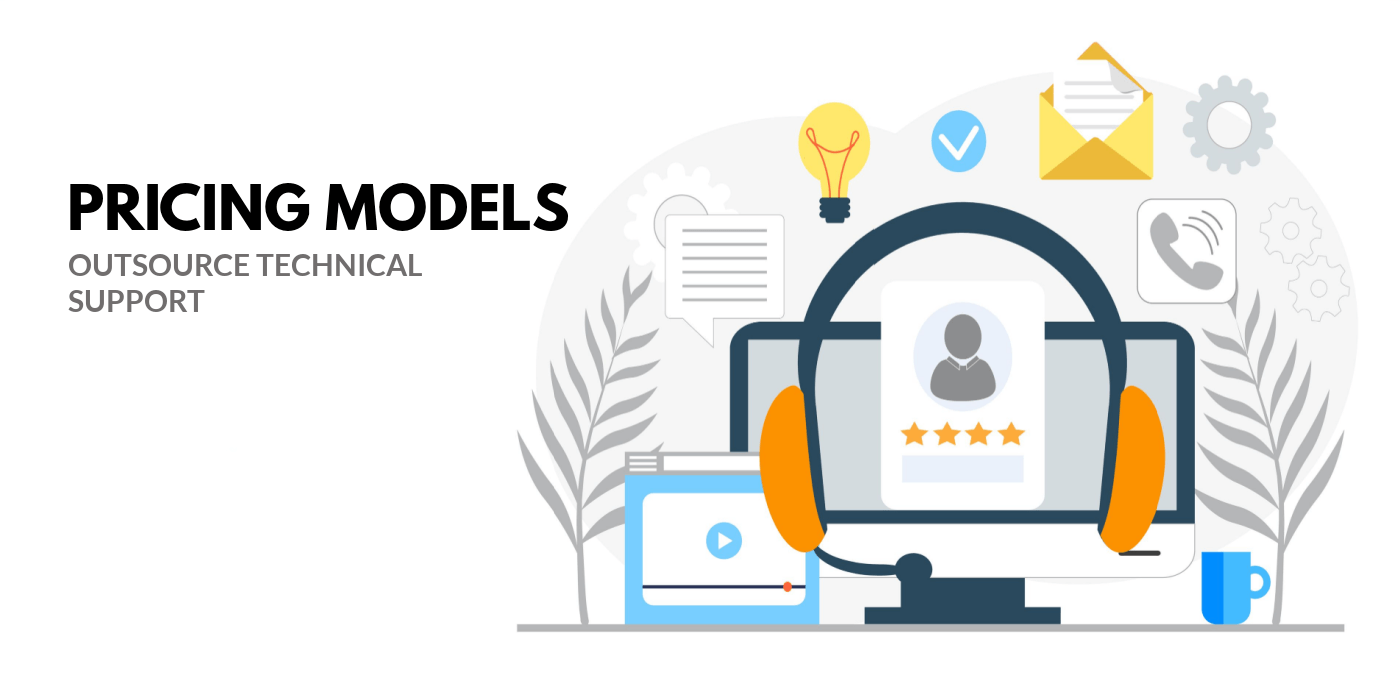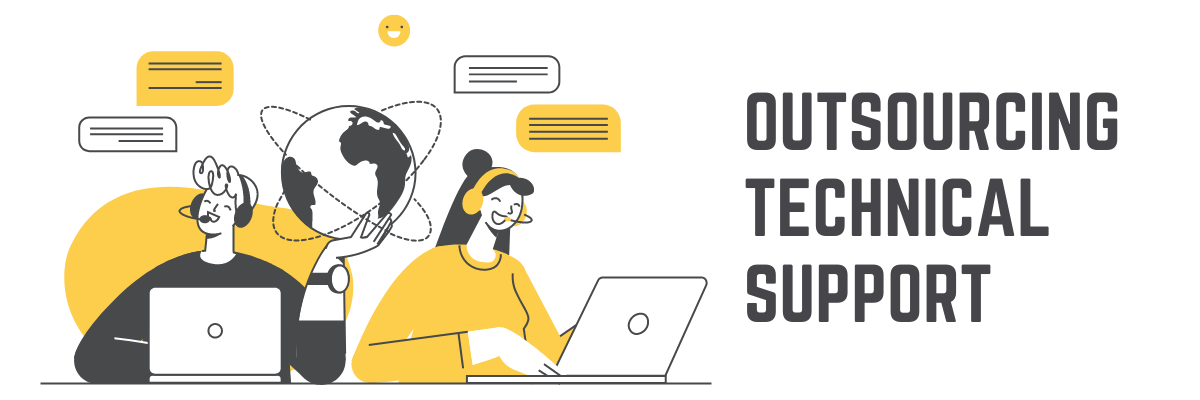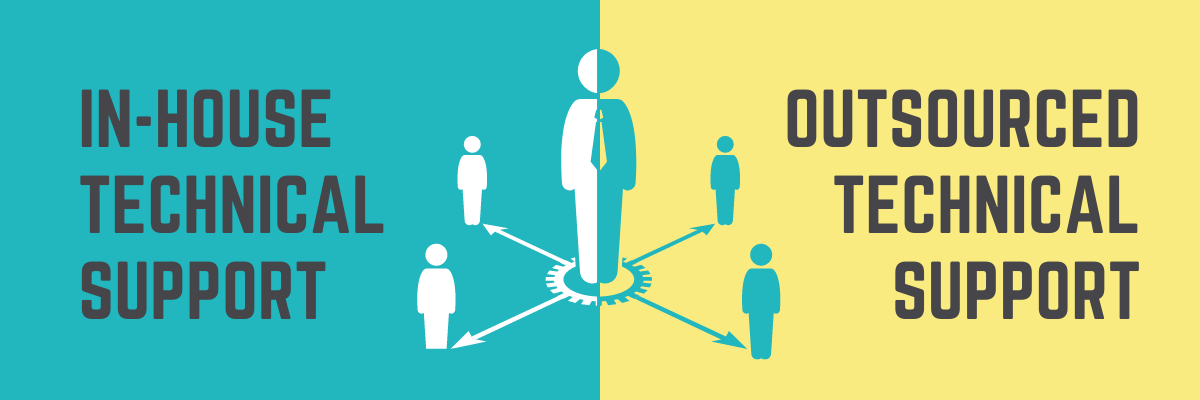Table of Contents
As a business owner or manager, your first thought when outsourcing a service integral to your business is probably the price. Finding out how much outsourcing will cost you is a crucial element in decision-making.
The same holds in outsourcing technical support. You want to know the costs and price factors included in this business activity.
This guide will help you learn about outsourced technical support pricing. We put together different costs and the best prices for IT outsourcing.
Let’s dive in.
What Are the Pricing Models of Outsourced Technical Support?

Technical support service providers use four pricing models: ad hoc fees, monitoring only, per-device fixed fee, and per-user flat rate. The cost you incur depends on the type of outsourced technical support pricing you choose.
Here’s a deeper dive into the four pricing models.
1. Ad Hoc Fees
Under this pricing structure, outsourcing your technical support is on demand, not ongoing. You hire a business process outsourcing (BPO) company only when you need technical support and pay them for its service. This scheme is ideal when you seldom require such support. Regular payments to your partner are not necessary.
But you have to pay a higher fee if a serious technical problem unexpectedly arises in your IT system. A third-party vendor charges a premium for its after-hours service to prevent your business from losing money and productivity due to work disruption. Convenience to you, your employees, and customers is the reason for the expensive rate.
The ad hoc payment plan is also ideal when you’re not heavily dependent on your IT network to run mission-critical aspects of the organization.
You can also adopt this model when your in-house technical support team performs regular checkups or maintenance of information systems. Then the outsourcing company serves as your standby support that resolves a major crisis your in-house team cannot handle.
2. Monitoring Only
The technical support outsourcing firm provides you with limited network monitoring and alerting services for a fixed monthly fee. It covers backup logs, antivirus and anti-spam updates, patch management, virus-free computers, disk optimization, general server capacity, critical service monitoring, and backup monitoring.
This pricing model is best for small businesses that are easy targets for hackers, cyber intruders, and virus authors. Many lack the financial and human resources, knowledge, and expertise to deal with these online attackers.
One of the biggest threats small enterprises face is malware attacks, including trojans and viruses. Hackers develop code to access your networks. They can corrupt computer data or steal critical information.
Malware invades your IT system when spam emails are opened, or files from other infected computer systems are shared. You can also get it when downloading files from an unsecured or suspicious website with your personal devices.
The most infamous malware attack via email is the ILOVEYOU virus. It impacted about 45 million users, resulting in $10 billion of damage when it struck in 2009. About 10% of all personal computers worldwide were hit.
3. Per-device Fixed Fee
Your BPO partner will charge a flat rate for technical support services based on the number of devices you want to be covered. It can scale the price depending on how many desktops, laptops, tablets, and mobile servers you use in a certain period. The more computers and digital gadgets that need care, the higher the charge.
This pricing model is simple and lets you conveniently monitor costs. You can easily make a budget plan for later additions. For example, you want every remote team member to have a laptop for enhanced collaboration. You compute the additional cost by the number of devices needed.
However, this pricing scheme can become costlier if many users request multiple devices, especially for a sales team frequently on the go and traveling from one place to another. Team members will ask for company laptops, tablets, and smartphones. If you’re expanding this team, then your technical support expenses will also go up.
4. Per-user Flat Rate
Your third-party vendor’s price tag is fixed, similar to the per-device price plan. Your cost is also scalable and dependent on the number of users. Your expenses on outsourced technical support go up when adding more users and down when downsizing.
This pricing model is ideal for small businesses with a limited budget. Technical support is available only to vital users and not everyone in the organization. In this way, you can maximize your financial resources.
In addition, the per-user fixed fee helps you with the business growth plans. Perhaps you will hire 30 more employees next year to prepare for an upcoming multimillion-dollar project. Given the expansion, you can precisely know how much technical support outsourcing will cost.
What Are the Types of Outsourced Technical Support Costs?

Outsourced technical support pricing relies on two types of outsourcing costs. You shoulder these expenses when delegating technical support to a BPO company.
1. One-off IT System Expenses
You pay for technical support and other IT outsourcing services only once. Below are the two one-time expenses you must incur for this particular activity.
- Office applications bulk purchase. The upfront payment is high because the installation is organization-wide. Another one-time expense included in this activity is hiring outside IT professionals to install and configure the software. Do this to avoid costly errors and delays. You don’t have to shell out extra money for technical maintenance after completing all tasks.
- Network deployment. Setting up connectivity, building email accounts, and implementing a system across the organization for better collaboration and higher productivity involves a lot of funds. Rather than deploying a system on your own, hire a BPO company. But hiring a BPO company’s further expertise and services means bearing another large expense.
2. Recurring IT System Costs
Recurring costs are ongoing expenses on technical support. They are rather complex to determine compared to one-time costs. One simple example is the regular payments you make for data security maintenance and upgrades.
But each business has a specific requirement that the outsourced technical support team should meet. Here’s how third-party vendors typically offer their outsourced technical support pricing:
- They determine service rates based on the total number of devices (desktops, laptops, tablets, and mobile phones), servers, and data volume.
- They estimate the number of support hours needed for each device and server. The more devices and servers you have, the higher the number of support hours required. The industry standard is about 25 support hours per device or server per year, while the service rate is $100 per hour.
- From these figures, you can estimate the cost of outsourced technical support with the simple equation below:

So if you have a combined total of 20 devices and servers, multiply these by 25 hours. The product is 500, which you multiply by $100. The total amount is $5,000 per year or about $4,200 per month.
- Regarding the data volume, the average industry rate is about $2,500 annually to store and duplicate up to 10,000 GB of data. That’s about $200 per month.
Your budget range should be between $1,000 and $9,000 for outsourced technical support. The exact price depends on the quantity of your IT and telecommunications equipment.
Other Cost Considerations
Maintenance and upgrades are also part of recurring IT systems costs. They add up to your overall technical support budget.
- Maintenance. Your technical support expenses can increase if your system requires regular management, including updating documentation and user support, testing data, deleting programs, repairing hardware and connectivity, and removing design errors. You pay more when you still use a legacy platform open to malfunctions and disruptions.
- Upgrades. Outsourced technical support costs can go up if your IT system needs to replace software, hardware, or other applications with the latest or better version. Upgrades are necessary to improve your platform. Depending on your industry, improvements can be ongoing, which means additional expenses.
You might be interested in reading about outsourcing data entry services for your technology company.
How Much Does It Cost To Outsource Technical Support Services?

The BPO company’s location is a major factor when determining the cost of outsourced technical support. You can purchase outsourced services for technical support onshore or offshore.
Onshore Outsourcing
Also known as domestic or local outsourcing, onshore outsourcing is transferring technical support tasks to an external service provider based in the same country as your main office. The benefits of this type of outsourcing include:
- Reducing operating costs
- Enhancing the quality of customer experience
- Addressing vital business requirements
- Maintaining high-quality control
- Eliminating time zone differences
- Helping prioritize core capabilities
Customer communication is easier with this outsourcing type because cultural differences and language barriers are minimal. This business approach matches your agents with the consumer’s background, language, and demographics for a better customer support experience.
However, there are drawbacks to onshore outsourcing:
- The costs include the salaries and benefits of the BPO company’s technical support agents.
- The wages are similar to your in-house team’s because both organizations operate under the same domestic labor laws.
When opting for onshore technical support outsourcing, you must deal with high labor rates. For instance, average rates per hour in the U.S. range from $80 to $250, while IT outsourcing services of companies based in Eastern Europe and Asia can be available at half to a third of the cost.
Despite these drawbacks, cost reduction through local outsourcing is still achievable. The onshore external service provider’s comparative advantage is its advanced technology, modern infrastructure, expertise, and wide business network.
With these advantages, the BPO company can offer its technical support services to clients at a lower cost than what you would pay for your own in-house IT department.
Offshore Outsourcing
Offshore outsourcing assigns business processes to a BPO company operating in a country with lower labor costs or taxes. The BPO provider’s workforce is trained and qualified to perform specific tasks for its clients.
Offshore pricing is better than onshore pricing, largely due to the lower wages paid to employees of offshored BPO companies. Asian countries offer a cost-effective (and competitive) workforce compared to the U.S., the UK, and Canada.
A search on Indeed’s employment website will show you the salaries of the different technical support positions in the U.S. versus Asian countries.

The advantages of the US technical support workforce over Asian countries are similar time zones, small language gaps, and minor cultural disparities with local customers.
The competitive edge of Asian countries is the affordable workforce. It can substantially reduce the cost of outsourced technical support services. Asian countries provide an ample supply of technically skilled employees who are fluent in English.
How Much Will You Save in Offshore Outsourcing?
Let’s compare offshore with onshore outsourcing. You can compute the cost from the table above to give a general picture of outsourced technical support pricing. Here are some examples.
Offshore
Let’s say your business operation is based in the US and you need the following outsourced technical support roles:
- Six technical support representatives (tier 1)
- Two specialists (tiers 2 and 3)
- One supervisor
If you outsource to an Asian country, the costs will be:
- Six technical support representatives x monthly salary = 6 x $432 = $2,592
- Two specialists x monthly salary = 2 x $468 = $936
- One supervisor x monthly salary = 1 x $591 = $591
To get the total costs, add the three sums: $2,592 + 936 + 591 = $4,119 per month. This total amount is your estimated monthly expenses when outsourcing to a BPO company in an Asian country.
Onshore
When outsourcing locally with the same number of employees, the costs will be:
- Six technical support representatives x monthly salary = 6 x $4,041 = $24,246
- Two specialists x monthly salary = 2 x $4,469 = $8,938
- One supervisor x monthly salary = 1 x $4,145 = $4,145
To get the total costs, add the three sums: $24,246 + 8,938 + 4,145 = $37,329 per month. This total amount is your estimated monthly expenses when outsourcing to a BPO company in the US.
Cost Difference
- Total offshore outsourcing costs (Asian country): $4,119 per month
- Total onshore outsourcing costs: $37,329 per month
To get the cost difference between the two outsourcing options, subtract $4,119 from $37,329. The result is $33,210.
Hence, the cost of offshore outsourcing is about nine times lower than the cost of onshore outsourcing.
But note that this computation is an estimate and not the exact way to determine the actual costs. You should contact your BPO prospect and a financial expert for the details.
Discover more about back-office outsourcing services for your technology company.
What Services Does Technical Support Provide?

A technical support outsourcing company offers different services, including:
- Answering customer technical questions about products or services
- Installing new software
- Networking and configuring computer systems or digital devices
- Determining software problems through a series of tests
- Checking product safety
- Monitoring IT systems for security and compliance
- Troubleshooting network problems
Toll-free numbers, live chat, and chatbots are the common channels used by a help desk. Other channels are websites, email, social media, and internet forums.
A Three-tiered Structure
Technical support has three levels to offer the best possible service. Knowing the three-tiered structure helps you better understand the services you get for the prices you pay.
Tier 1 (T1) Support
This level entails gathering customer information, evaluating problem details, and providing solutions. T1 support can address 75% of all user technical problems using basic knowledge and management tools.
Examples of simple solutions are uninstalling or reinstalling basic software applications, walking through the application menus, addressing username and password issues, and configuring proper hardware and software setup.
Tier 2 (T2) support
This tier tackles the other 25% of user technical issues beyond T1’s capability. T2 support is more in-depth and expensive than T1. The technical staff has higher skills and broader knowledge of your product or service.
Also called support line 2 or administrative level support, T2 applies sophisticated troubleshooting and analysis procedures. However, if this team fails to provide a solution, then the problem is elevated to level 3.
Tier 3 (T3) support
T3 support is the last line of defense. Specialists at this level are the most competent and high-priced personnel. They deal with the hardest technical problems. Helping T1 and T2 technicians is their primary task. They are also in charge of developing solutions to new or unexpected issues.
If this team is still unsuccessful in fixing issues because of inherent defects (in materials, design, and more), a product replacement is a must.
The three-tiered structure is directly connected to outsourced technical support pricing. It contributes to the overall cost of outsourcing your technical support.
Is Outsourcing Better Than an In-house Technical Support Team?

There’s no doubt that outsourcing your technical support is better in terms of financial costs. Running your in-house technical support department involves expenses you will not incur when outsourcing. These costs include:
- Salary and compensation. Regularly pay for the salary and compensation of your full-time technical support employees. You’ll also have to shoulder other non-financial benefits such as sick leaves, holiday pay, insurance, and retirement plans.
- Office space and equipment expenses. You have to spend a great deal of money on additional office space for the technical support team, hardware, other related equipment, and extra office supplies. Most are one-time expenses, and some are recurring, including system maintenance and upgrades.
- Training costs. You must shoulder the costs of training and upskilling your technical support team. They must update and improve their knowledge and skills to resolve unfamiliar technical issues that can be costly, particularly in the areas of cybersecurity.
The Bottom Line
Outsourced technical support pricing essentially depends on your technical support requirements. For one, decide how many members are necessary for the third-party technical support team and what levels or tiers to hire.
You should also choose the best pricing model to maximize outsourcing and identify the expense types to incur when tapping into the services of a BPO company. Lastly, choose whether to outsource locally or overseas.
While we can’t give you an exact cost, you can estimate how much you’ll spend based on the considerations discussed in this article.



